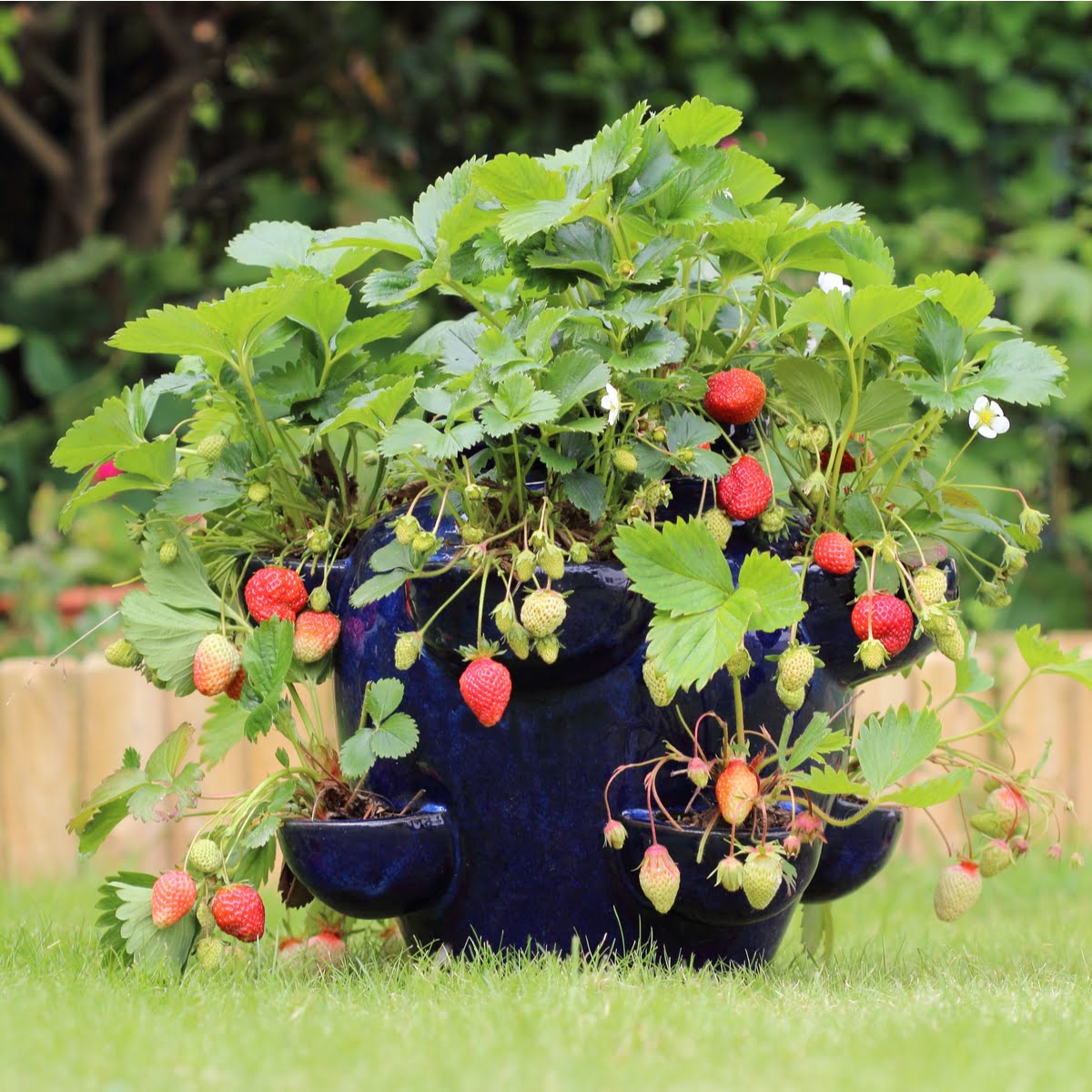When cultivating strawberries in a container, it is crucial to choose suitable companion plants that can optimize their growth and provide mutually beneficial attributes. By selecting plants that offer various benefits such as pest control, improved pollination, soil preservation, or aesthetic appeal, you can create a harmonious environment that maximizes the potential of your strawberry plants. This article explores the ideal plant companions for strawberries in containers, guiding you towards achieving a thriving and bountiful strawberry harvest.
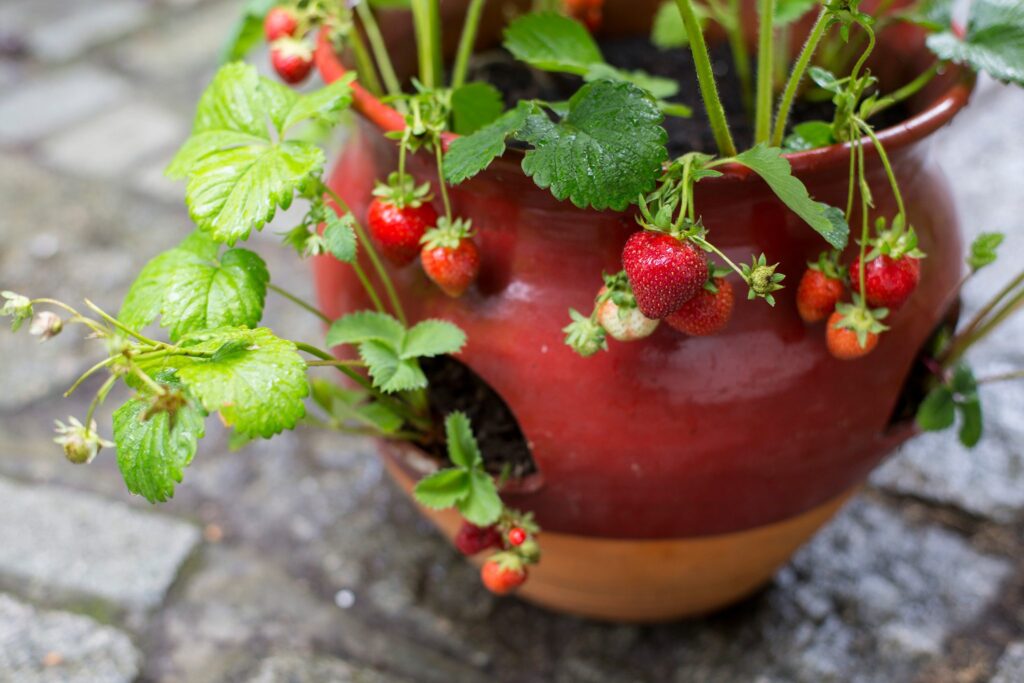
Best Companion Plants for Strawberries
When growing strawberries in containers, it is important to consider the companion plants that can be grown alongside them. Companion planting involves growing different plants together that have mutual benefits, such as enhancing growth, deterring pests, or attracting pollinators. By choosing the right companion plants for your strawberries, you can create a harmonious and productive container garden. In this article, we will explore the best companion plants for strawberries and discuss the factors to consider when choosing them.
1. Flowers
Flowers are not only a beautiful addition to any garden, but they can also provide numerous benefits when planted alongside strawberries. Certain flowers attract beneficial insects, such as bees and ladybugs, which help in pollinating the strawberry flowers and controlling pests. Additionally, flowers can add visual interest and diversity to your container garden. Here are some flowers that make great companions for strawberries:
Marigolds
Marigolds are known for their vibrant colors and distinct fragrance. These flowers are excellent companions for strawberries as they help repel pests like aphids, nematodes, and beetles. Marigolds contain compounds that deter these harmful insects, making them a natural pest control method.
Nasturtiums
Nasturtiums are not only visually appealing with their bright, edible flowers, but they also assist in pest control. These flowers attract aphids, caterpillars, and other pests away from the strawberries, acting as a sacrificial plant. Additionally, nasturtiums release a mustard-scented oil that repels harmful insects, creating a protective barrier.
Alyssum
Alyssum is a low-growing flower that forms a dense carpet of delicate blooms. It is an ideal companion plant for strawberries as its tiny flowers attract predatory insects like hoverflies and lacewings, which feed on aphids, thrips, and other pests. This natural form of pest control can help protect strawberries from damage.
Calendula
Calendula, also known as pot marigold, is another flower that can benefit strawberries. Its vibrant orange and yellow flowers not only add beauty to the container garden but also attract pollinators like bees and butterflies. Additionally, calendula has natural anti-fungal properties, which can help prevent diseases in strawberries, such as gray mold.
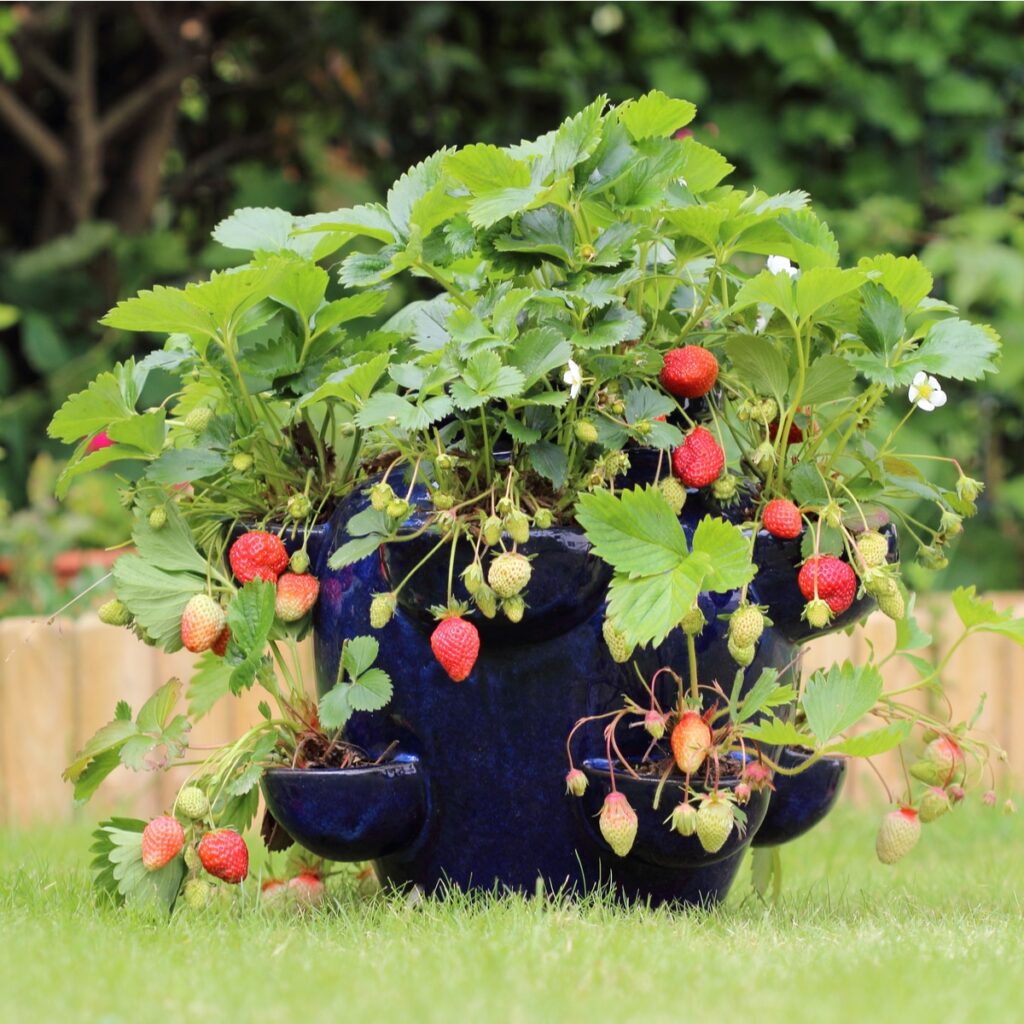
2. Herbs
Herbs not only enhance the flavor of your culinary creations but can also act as excellent companion plants for strawberries. Many herbs have strong scents that can repel pests, and some even attract beneficial insects. Planting herbs alongside strawberries can create a symbiotic relationship that benefits both plants. Here are some herbs to consider planting alongside strawberries:
Thyme
Thyme is a fragrant herb that is known for its ability to repel pests like whiteflies, cabbage worms, and spider mites. Its aromatic oils deter these harmful insects, keeping them away from strawberries. Thyme can also attract bees, which are essential for pollination.
Oregano
Oregano is a versatile herb that can provide numerous benefits when planted with strawberries. Its strong scent repels pests like aphids, mites, and cabbage loopers. Oregano also attracts beneficial insects such as hoverflies and parasitic wasps, which prey on strawberry pests.
Chives
Chives are a member of the onion family and have a distinct onion-like scent. This strong aroma helps repel pests like aphids, thrips, and mites, which can cause damage to strawberries. Planting chives near your strawberry container can assist in pest control.
Dill
Dill is an aromatic herb that can improve the overall health of strawberry plants. It attracts beneficial insects like hoverflies, lacewings, and ladybugs, which prey on strawberry pests. Dill also acts as a trap crop, luring harmful insects away from strawberries.
3. Vegetables
Growing vegetables alongside strawberries in containers can provide a dual benefit. While the strawberries serve as a delicious fruit crop, the vegetables can offer edible produce, maximize space utilization, and create a diverse container garden. Here are some vegetables that make great companions for strawberries:
Lettuce
Lettuce is a cool-season vegetable that thrives in the same conditions as strawberries. By planting lettuce in the same container, you can utilize the vertical space and increase the yield of your container garden. Additionally, lettuce provides shade and helps reduce weed growth around the strawberries.
Spinach
Spinach is another leafy green vegetable that grows well alongside strawberries. Like lettuce, it can maximize space utilization in your container garden. Spinach has shallow roots, which makes it compatible with strawberries, as they both prefer well-drained soil.
Radishes
Radishes are quick-growing root vegetables that can be interplanted with strawberries. They mature relatively fast and can be harvested before the strawberries spread their leaves fully. Radishes also help break up compacted soil and improve aeration for the strawberry plants.
Bush Beans
Bush beans are legumes that fix nitrogen in the soil, making them excellent companions for strawberries. Nitrogen is a crucial nutrient for plant growth, and by planting bush beans in the same container, you can provide a natural source of nitrogen for the strawberries. Additionally, bush beans have shallow roots, so they won’t compete with strawberries for water and nutrients.
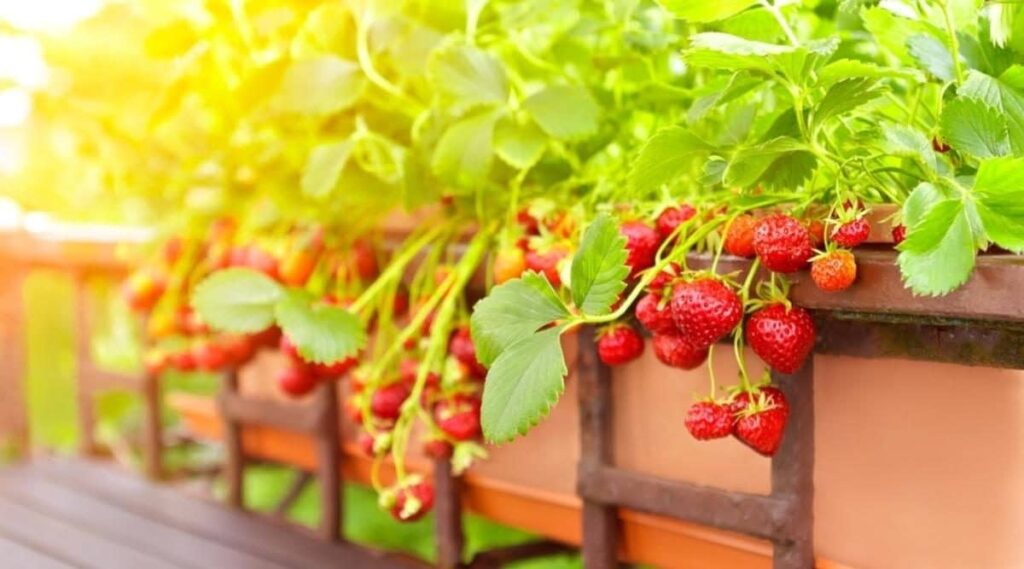
Factors to Consider When Choosing Companion Plants
While selecting companion plants for strawberries, it is essential to consider several factors to ensure compatibility and maximize the benefits. The following factors should be taken into account when choosing companion plants:
1. Sunlight Requirements
Different plants have varying sunlight requirements, so it is important to choose companion plants that have similar preferences. Some plants prefer full sun, while others thrive in shade. Matching the sunlight requirements of your companion plants with strawberries will ensure both plants receive the necessary amount of light for optimal growth.
2. Soil Preferences
Plants have specific soil preferences, such as acidity levels, drainage, and nutrient requirements. It is crucial to select companion plants that have similar soil preferences to strawberries. This will help maintain a balanced soil environment and prevent competition for nutrients.
3. Watering Needs
Plants have different watering needs, ranging from drought-tolerant to moisture-loving. It is important to choose companion plants that have similar watering requirements to ensure proper irrigation and prevent over or under-watering.
4. Growth Habits
Considering the growth habits of companion plants is vital for optimizing space and preventing overcrowding. Some plants grow tall, while others remain low or spread horizontally. Selecting companion plants with compatible growth habits will allow for efficient space utilization and prevent shading or overcrowding of the strawberries.
1. Sunlight Requirements
When selecting companion plants for strawberries, it is crucial to consider their sunlight requirements. Some plants thrive in full sun, requiring at least six to eight hours of direct sunlight daily. These sun-loving plants include marigolds, nasturtiums, and some herbs like oregano and thyme. On the other hand, some plants prefer shade or partial shade and can tolerate less sunlight. Shade-loving plants like alyssum and certain herbs, such as chives, can be suitable companions for strawberries in containers if placed in areas with lower light levels.
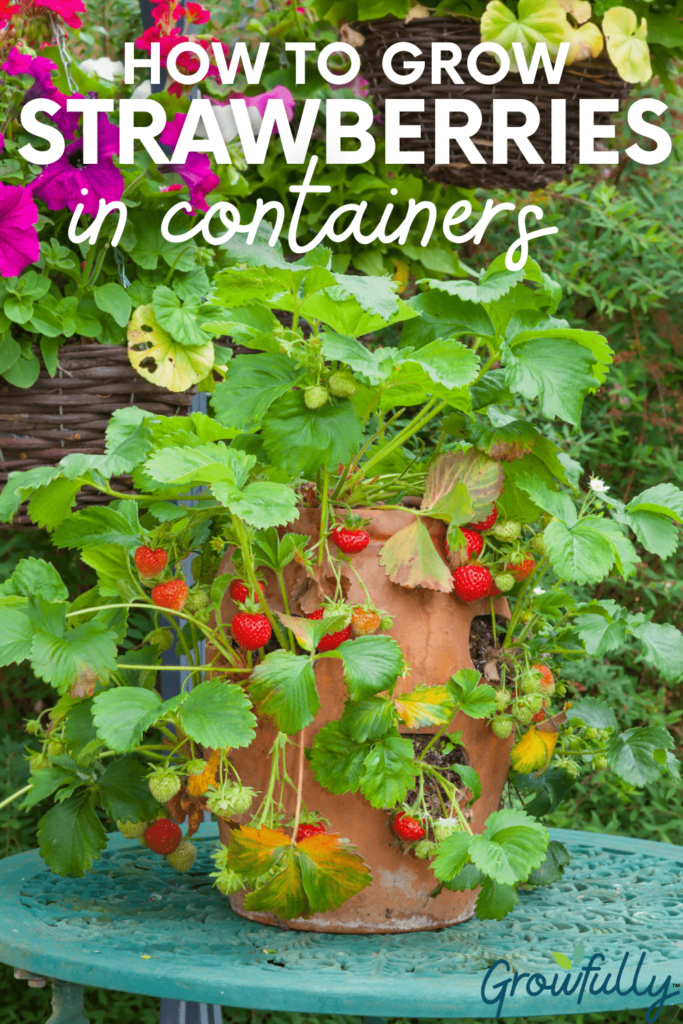
2. Soil Preferences
The soil preferences of companion plants should align with those of strawberries to ensure both plants thrive. Some plants prefer acidic soil with a pH below 7, while others thrive in alkaline soil with a pH above 7. Acid-loving plants like blueberries and azaleas may not be the best choice as companion plants for strawberries, as strawberries prefer slightly acidic soil. However, certain herbs like thyme and oregano can adapt to a range of soil pH levels and make compatible companions.
3. Watering Needs
Watering requirements play a vital role in the health and growth of companion plants. Some plants, known as drought-tolerant plants, can survive with less frequent watering and prefer drier soil conditions. These plants, such as succulents or lavender, may not be suitable companions for strawberries, as strawberries require consistent moisture for optimal growth. Conversely, moisture-loving plants, such as lettuce and spinach, require more frequent watering and can be compatible companions for strawberries if their watering needs are met.

4. Growth Habits
Understanding the growth habits of companion plants is essential for efficient space utilization and preventing overcrowding in the container. Tall plants can provide shade to strawberries or compete for sunlight, which can hinder their growth. Examples of tall plants include sunflowers or pole beans, which may not be the best companions for strawberries in containers. Low-growing plants like alyssum and certain herbs, such as thyme, can be suitable companions as they won’t overshadow or overcrowd the strawberries. Spreading plants like nasturtiums or herbs like oregano can help fill in empty spaces in the container and create a visually appealing arrangement.
Conclusion
In conclusion, choosing the right companion plants for your strawberries in container gardening can greatly benefit their growth and productivity. Flowers like marigolds and nasturtiums attract beneficial insects and repel pests, while herbs like thyme and oregano provide natural pest control and attract pollinators. Vegetables such as lettuce, spinach, radishes, and bush beans can maximize space utilization and provide additional edible produce. When selecting companion plants, it is important to consider factors such as sunlight requirements, soil preferences, watering needs, and growth habits to ensure compatibility and create a harmonious container garden. By implementing companion planting techniques, you can create a thriving and diverse ecosystem within your strawberry container garden.
